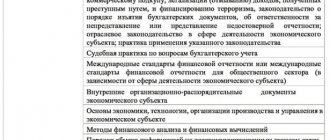Sample job description for a motor vehicle mechanic
General provisions
1.1. The document regulates the following aspects of the professional activity of a motor vehicle mechanic: job tasks, working conditions, rights, duties, area of responsibility. 1.2. The hiring and subsequent dismissal of a mechanic is carried out through the creation of an order by the management of the enterprise. This procedure is controlled by Russian labor legislation. 1.3. The immediate superiors of a motor vehicle mechanic are:
- chief mechanical engineer;
- director of operations;
- CEO of the company.
In case of their absence, this function is transferred to deputy employees.
1.4. In the absence of a vehicle mechanic at work for valid reasons (illness, vacation, business trip), his tasks are delegated to employees who have the appropriate knowledge, qualifications, and work experience. Replacement is carried out in accordance with the internal rules of the organization. 1.5. The following requirements apply to applicants for the position of motor vehicle mechanic:
- higher/secondary specialized education;
- One year of work experience in the specialty.
1.6. A vehicle mechanic must be knowledgeable about:
- methodological documents and standards that address organizational issues of repair and maintenance of work equipment;
- technologies for manufacturing the company's products;
- organizational aspects of the repair service;
- technical parameters and structural details of work equipment;
- rules for using the equipment, the purposes for which it is used and the mode of operation;
- methods and technologies for carrying out repair and installation work;
- standards for filling out technical passports, defective statements, instructions for operating equipment and other technical documentation;
- rules for acceptance and delivery of equipment upon completion of repair work;
- provisions for the rational distribution of work responsibilities during the repair process;
- provisions for the modernization of devices and support for repair work;
- the basics of organizing labor activity, management and production spheres;
- labor safety standards;
- labor legislation (Labor Code of the Russian Federation) and the code of laws on environmental protection.
1.7. In the course of his work, a motor vehicle mechanic relies on:
- regulatory documentation and methodological materials that affect his professional competence;
- charter adopted by the organization;
- labor regulations;
- orders coming from the general director of the enterprise and immediate superiors;
- this instruction and the employment contract;
- fire safety rules.
Job responsibilities
2.1. The job functions of a vehicle mechanic include the following tasks:
- Conducting a preventive inspection of the enterprise’s transport;
- organization of constant, reliable and technically correct use of specialized equipment, maintaining devices in working condition;
- creating plans and schedules for inspection, testing and preventive maintenance of equipment that comply with the rules of the Unified Code of Preventive Maintenance Work;
- creation and implementation of methods to reduce the cost of repairing vehicles/trailers;
- planning the maintenance of entrusted machines;
- control over the repair of devices and implementation of production preparation in the technical field;
- taking part in the provision of technical assistance to enterprise vehicles;
- organization of preparation of technical and reporting documents;
- organization of recording of devices and their transfer to authorized persons at the end of the repair;
- filling out and sending applications for the purchase of materials and spare parts required for vehicle repair work;
- taking part in experimental measures that are aimed at introducing and mastering innovative technologies, as well as in testing incoming equipment;
- carrying out high-quality repairs within the time limits allocated by immediate superiors and promoting the rational use of technical materials;
- following safety and labor protection rules during repair work;
- helping to reduce the number of unplanned repairs and situations in which equipment is idle;
- organizing the actions of enterprise employees who are subordinate to him;
- using personal protective equipment developed by the enterprise for a specific type of work, and wearing the prescribed uniform.
Rights
3.1. A vehicle mechanic is vested with the following powers:
- monitoring the timely completion of tasks and instructions from subordinate employees;
- sending requests and obtaining the necessary information and documents that affect the professional activities of the mechanic and his subordinate workers;
- interaction with other structural divisions and companies on work issues within the framework of professional competence;
- obtaining information from the management of the enterprise that is necessary to perform job duties and coordinate the work of subordinates;
- requirement from the management of the enterprise to provide appropriate conditions for the correct performance of professional duties;
- requirement from the management of the enterprise to timely issue personal protective equipment and a complete set of equipment for repairs;
- making proposals to improve the work process and improve its conditions;
- cessation of production activities in the event of a threat to the life of the auto mechanic and his colleagues.
Responsibility
4.1. An auto mechanic bears disciplinary liability when committing the following actions:
- causing material damage to the enterprise and/or its employees;
- sending false information to management about the quality and condition of the repair work carried out;
- neglect of the implementation of labor duties and subsequent evasion;
- refusal to execute or incorrect execution of orders coming from the general director of the enterprise or from immediate superiors;
- failure to complete repair work within the established time frame;
- incorrect operation of equipment and other devices, leading to malfunction of devices for repair work;
- refusal to assist in preventing revealed violations that pose a threat to the work of the organization, as well as the safety of employees located on its territory;
- ignoring fire safety standards at work, neglecting protective equipment.
Working conditions
5.1. A motor vehicle mechanic is vested with financial responsibility for the repair equipment and other equipment entrusted to him. 5.2. A vehicle mechanic is subordinate to employees and structural subdivisions of the organization, which are listed in the relevant documents. 5.3. An auto mechanic carries out repair work based on established standards for performing professional vehicle maintenance tasks.
Mechanic - qualification requirements
Before applying for a job as a mechanic, you will be required to meet certain qualification requirements. First of all, let's figure out what it is. A qualification is a special level of training provided by higher or secondary educational institutions in Russia. There are two types of qualification levels: secondary vocational and higher education. Nowadays, in order to get a good and well-paid job, you need to have a completed higher education.
In order to obtain a mechanic position, the qualification requirements are as follows. You must have a secondary technical education (a college or vocational school diploma) and a certain amount of work experience - about 4-5 years. Or, higher professional education (this is a university diploma) and a little work experience - about 2 years. Naturally, the qualification requirements for a mechanic do not always imply work experience in the profession; you can get a job without it, but what is certain is that people with a higher education are now much more willing to hire than without it. Still, experience plays a big role in this profession. If you are an experienced mechanic and have been tinkering with pieces of iron for years, then you will have no time to rest.
Responsibilities of a Mechanical Technician
First of all, the responsibilities of a mechanic in a company include timely and proper repair of all equipment. The mechanic is responsible for ensuring that the equipment is used correctly; if someone does something wrong, he must inform that person about the correct operation of the equipment. Also, the responsibilities of a mechanic at an enterprise include scheduling scheduled inspections and repairs of all equipment in the enterprise. This is done to prevent unwanted breakdowns, as a preventative measure, for better operation of the equipment.
Another of the main responsibilities of a mechanic is to replace old worn-out equipment with new ones. Both installation and familiarization with new equipment. Each new equipment must be inspected and put into operation under the supervision of a mechanic. The mechanic must also try and implement the latest technologies to improve the operation of equipment and simplify its repair.
The responsibilities of a production mechanic include maintaining reporting documentation. For example, consumption of lubricants, spare parts, etc. This is also very important in the mechanic’s profession because all these materials are quite expensive and their consumption must be monitored by higher-ups in production. It is very important to know how much has been spent or is needed in the future, so as not to remain guilty of theft or shortage of materials.
Rules for drawing up job descriptions
The job description does not imply strict design rules. Its compilers are guided by the specifics of a particular enterprise and develop the points independently. Therefore, instructions for employees who occupy the same position in different companies may vary. The reason is that organizations have different requirements for applicants based on their profile.
The following officials are responsible for creating job descriptions:
- HR department specialist;
- HR specialist;
- HR department employee.
The job description is printed in one copy and provided to the employee. If there are several auto mechanics in production, then each of them is issued this document. The instruction becomes legally binding when three signatures are placed on it:
- from the employee for whom the document was drawn up;
- from the employee responsible for familiarizing the colleague with the instructions;
- from the general director of the enterprise.
Responsibilities of a Garage Mechanic
There is a separate category - these are the duties of a garage mechanic. These are the so-called auto mechanics, employees of car dealerships, service stations and other enterprises related to cars. The duties of a garage mechanic include servicing the vehicles of all customers who come to their service station or auto repair shop. Ensure quality and correct repairs of customer vehicles. Perform the following functions: repair of the engine system, brake system, carburetor, etc. Also, the duties of a garage mechanic include discussing with the client issues of further operation of the road vehicle, and instructing him regarding the features of the car. Of course, it is the responsibility of a garage mechanic to ensure that he has all the materials he needs to repair vehicles. In a word, the responsibilities of a mechanic are basic and understandable to every specialist.
And knowing all the responsibilities and rights of your profession, you can become an indispensable employee of your enterprise. And even more so if you have a degree in mechanics. Decent, hardworking mechanics are in short supply these days. Therefore, if you have a mechanic’s education and you know everything that you have to do at an enterprise, then you can be sure that such a mechanic will never go missing and will always be needed in one or another production. Being a mechanic is becoming fashionable and prestigious.
«>
Job description structure
The lack of a uniform template led to the development of informal rules for drawing up instructions. They involve dividing the document into five sections:
- General provisions;
- Job responsibilities;
- Rights;
- Responsibility;
- Working conditions.
The authors of the instructions have the right to change points and give the document a different structure. But most employees are guided by the above plan due to its brevity and simplicity.
Information about management
Information about the director of the enterprise is placed in the upper right corner of the job description. The compiler provides the following information:
- Full name of the boss;
- position held;
- Business name;
- signature with transcript.
General provisions
General provisions describe the formal aspects of the position of a motor vehicle mechanic:
- designation of the category to which the position belongs;
- an indication of the order on the basis of which the employee was hired;
- subordination issues: to whom does the auto mechanic report and who is subordinate to him;
- employee qualification requirements (education, additional courses, work experience, etc.);
- regulations and legal acts that a vehicle mechanic must be aware of;
- the amount of knowledge that must be acquired by an employee at the time of taking office.
Reference! Regardless of the position, the list of documents indicates fire safety and labor protection rules.
Job responsibilities
The section on job responsibilities is central. The quality of its development determines the coherence of the work of employees in production. The purpose of this chapter is to provide the employee with comprehensive information about the tasks ahead. The functions of a car mechanic consist of the following general points:
- ability to use equipment and check its serviceability;
- maintaining working tools in acceptable condition;
- organization of repair work;
- preventing device malfunctions;
- introduction of new technologies into production;
- carrying out repair work within the established time frame.
Important! If auto mechanics at an enterprise are responsible for different areas of repair, this item must be included in the job description.
Rights
Rights include a list of actions that a motor vehicle mechanic takes to improve working conditions. This section includes the following options:
- taking initiative to optimize the production process;
- requirement from management to provide the necessary equipment;
- involvement in the work of other departments of the organization within their competence;
- obtaining from management documents and other information necessary to perform professional duties.
The rules are written to outline the range of opportunities that an employee has the right to afford. If he abuses his powers, he will be subject to disciplinary liability.
Responsibility
Responsibility refers to the consequences that will befall a car mechanic for certain actions. These actions are detrimental to the organization, the staff, or the mechanic himself. The category of misconduct includes the following actions:
- disobedience to superiors;
- malicious violation of the conditions specified in the employment contract;
- allowing equipment for which the employee is responsible to malfunction;
- negligent attitude towards fulfilling duties and ignoring designated deadlines;
- incorrect performance of official duties;
- causing material damage to the organization.
All these offenses lead to punishment. The form of punishment can be different - from a reprimand to dismissal from work and legal proceedings.
Reference! In the “Responsibility” section there should be a point indicating that any penalties are carried out taking into account Russian labor legislation.
Mechanic's position depending on the type of activity
The functional responsibilities of a mechanic depend on what field of activity he works in and what position he occupies, namely:
- Mechanical engineer.
- Mechanic for releasing vehicles onto the line.
- Chief mechanical engineer.
- Driver mechanic.
- Garage (vehicle) mechanic.
In addition, the specifics of the work of a specialist of this type depend on the type of equipment or vehicle that is under his control. For example, a marine mechanic, among other things, must undergo special military training and have appropriate education, which includes knowledge of the science of shipbuilding. Each company has the right to set its own requirements for a mechanic job applicant, which they stipulate in the relevant contract, namely the job description. Before signing an employment contract, the employer must familiarize the future employee with this type of document.
Let's consider the features of the functional and job responsibilities of a mechanic, depending on the type of activity.
All-terrain vehicle driver 6th category etc.
Repair responsibilities are a narrower area of activity. Accordingly, the job description provides a more detailed description of the conditions and procedure for repairs.
During the absence of a mechanic (illness, vacation, etc.), his duties are performed by a person appointed by order of the director of the enterprise. This person acquires the corresponding rights and is responsible for the proper performance of the duties assigned to him. Ensures trouble-free and reliable operation of all types of equipment, their proper operation, timely high-quality repairs and maintenance, carrying out work on its modernization and increasing the cost-effectiveness of equipment repair services.
Inspection procedure
The procedure for pre-shift inspection contains a complete list of vehicle elements that need to be checked (click on the picture to enlarge it):
Thus, you won’t have to do anything supernatural when checking. You just need to check that the car is in full working order.
If you work as an inspector, I recommend printing out the table above and checking vehicles in accordance with it.
Separately, I would like to draw your attention to the fact that the inspector must also check that no changes have been made to the design of the car.
For example, that LPG has not been installed or the sides of the truck have not been extended.
Control functions
The position requires:
- Control of targeted and rational spending of funds for repair work and major overhauls.
- Monitoring the correct storage of equipment.
- Carrying out timely inspections and presenting equipment passports to state technical supervision authorities to make the necessary changes.
- Taking measures to detect equipment that is not involved in production or repair processes.
- Ensuring compliance with health and safety rules when carrying out repair work of any complexity class.
Who can conduct a pre-trip technical inspection?
7. Control is carried out by a controller of the technical condition of vehicles or a controller of the technical condition of urban ground electric transport vehicles (hereinafter referred to as the controller).
Technical control must be carried out by a special employee - controller .
Detailed requirements for controllers are given in a separate regulatory document (clause 14.3):
| Education | Speciality | Additional requirements |
| secondary vocational | 02.23.03 Maintenance and repair of motor vehicles | — |
| not lower than average professional | in specialties group 23.00.00 Equipment and technologies of land transport | work experience in the field of technical condition monitoring and maintenance of vehicles for at least one year |
| not lower than average professional | any specialty | Diploma of professional retraining with qualification of inspector of technical condition of vehicles |
Pay attention to the last row of the table. Any employee of the organization with at least secondary vocational education can undergo professional training, after which he will be able to work as a controller.
For example, consider the smallest version of the organization. An individual entrepreneur is engaged in the transportation of goods, i.e. he himself acts as a driver. In this case, he can undergo professional retraining. After this, he will have the right to check the car before leaving and put a mark on the control on the waybill.
However, there is another option. You can enter into an agreement with a mechanic who will come to the organization every day, check the vehicles, mark the waybills and fill out the appropriate log.
In this case, the following point must be taken into account:
5. Pre-trip or pre-shift monitoring of the technical condition of vehicles (hereinafter referred to as control) is carried out before the vehicle leaves the parking lot (parking space) intended for parking the vehicle upon return from the trip and the end of the vehicle driver’s shift (hereinafter referred to as parking).
So you need to check the car where it is parked. That is, it is impossible to conclude an agreement according to which cars will go to another organization to undergo pre-trip control. All inspections must take place on site.
If the organization is large and there are a lot of cars, then it makes sense to hire a separate employee who will deal with pre-trip checks.
If there are only a few vehicles involved in transportation, then it will be cheaper to enter into an agreement with a specialized organization, whose employee will come and release the vehicles for the trip.
Job Mechanic at Mikhnevo facility, Moscow region.
Supervises employees of enterprise departments that repair equipment and maintain it in working condition. Organizes the preparation of calendar plans (schedules) for inspections, checks and repairs of equipment, requests for centralized implementation of major repairs, for obtaining materials, spare parts, tools, etc. necessary for scheduled maintenance and routine repairs, drawing up passports for equipment, specifications for spare parts and other technical documentation.
It is becoming unclear what will happen to the “qualification training” program. The “advanced training” program remains relevant for now, since Order No. 13/11 refers to it.
Qualification directory for positions of managers, specialists and other employees dated April 29, 2008.
Introduction of new products
The work of the chief mechanic department involves the introduction of new developments:
- participation in the development and implementation of measures to ensure safe working conditions when repairing equipment, as well as its operation;
- consideration of improvement proposals that relate to improving working conditions and equipment operation;
- providing feedback on improvement proposals;
- assists in the implementation of improvement proposals;
- taking part in the formation of applications for the purchase of new equipment on leasing terms;
- management of employees of divisions and departments that carry out repair work and maintain equipment, buildings, and structures;
- organization of employee training.










